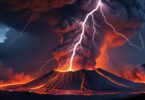Light pillars are a fascinating atmospheric optical phenomenon in which vertical beams of light appear to extend above or below a light source. These ethereal columns can be seen during chilly weather and are frequently mistaken for auroras due to their bright look.
Formation of Light Pillars
Light pillars form when light reflects off flat hexagonal ice crystals hanging in the atmosphere. These crystals, which are commonly found in high-altitude clouds such as cirrostratus or cirrus clouds, align horizontally as they descend through the atmosphere. Each crystal functions as a tiny mirror, reflecting light from the sun, moon, and artificial lighting. The collective reflection of crystals at different elevations gives the illusion of a vertical column of light. This is an optical illusion; the light does not physically extend into the sky, but it appears to because of the aligned reflections.
Natural and Artificial Light Sources
While sunlight and moonlight can create light pillars, artificial sources such as streetlights are prominent culprits, particularly in urban areas. Light pillars are frequently seen above city lights in cold climes when ice crystals are present in the lower atmosphere. The color of the light pillar correlates to the light source, resulting in a variety of hues that illuminate the night sky.
Optimal Viewing Conditions
Light pillars are most abundant in polar regions and during the winter months, when temperatures are low enough to allow ice crystals to form in the atmosphere. Clear, quiet evenings maximize your chances of seeing this phenomena, as turbulent air can disturb the alignment of ice crystals required for light pillars to develop. Light pillars require patience and a little luck to spot because they are dependent on precise meteorological conditions.
Photographing Light Pillars
To capture the beauty of light pillars, you need a camera with long-exposure capabilities. A tripod is required to keep the camera stable during exposure. Photographers should experiment with different exposure periods and ISO levels to get the desired look, keeping in mind that the intensity and length of light pillars can vary.








